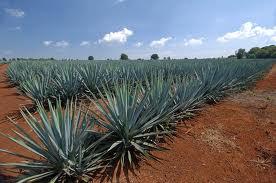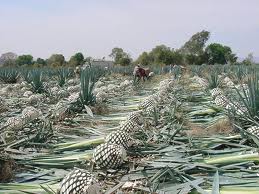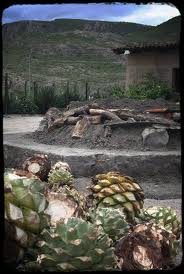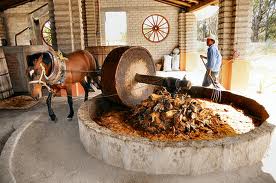I first published this post in 2012. At the time, mezcal was little known. And while the battle for recognition is still uphill, mezcal is far more popular today than it was back then. Since 2012, mezcal sales are up almost four times, and the vast majority of bars, restaurants and liquor stores, carry at least one brand.
I still spend a lot of time spreading the gospel of mezcal, and more times than not, the conversation begins with the comparison of mezcal to tequila. I use it as an opener at cocktail parties. I just walk up to a random person and ask them “Do you know what the difference is between tequila and mezcal?” They usually turn and walk away. OK, maybe that is not the way it goes down, but it could happen that way!
But this question usually is the starting point when people are curious about mezcal. In many ways, mezcal can best be understood by simply tasting it next to tequila. What will you find? Most notably, you will find mezcal to be smoky by comparison. Intense and smoky like a campfire to some, or subtle and gentle to others. The person who finds the smoke to be light is usually a scotch, bourbon or whiskey drinker, and is used to bold spirits. If you find mezcal to be intensely smoky, there is a good chance you are not accustomed to drinking spirits neat.
This post gives you the basics, but if you really want to understand and appreciate what separates mezcal from tequila, you need to read my book Holy Smoke! It’s Mezcal! (shameless self-promotion perhaps, but hey, the blog is free so this is my form of selling ad space!). The book is available on Amazon. Notice the cool cover shot to the right. Buy a copy – I promise you won’t be disappointed! Now back to our regularly scheduled program…
I believe that for most people tequila leads to mezcal (even though all tequilas are mezcals, but we will come back to that). Tequila leads to mezcal because for most of us, it started with tequila. We traveled down a path that likely started with bad tequila, bad experiences, and bad results the next morning. Then we slowly found our way back to the good 100% agave tequilas that started showing up in the 90’s. And maybe we enjoyed the extra anejos that move tequila toward cognac. And then, what? What else is out there? Ahhh mezcal….I’ve heard about that. The rise of the extra anejos coincided with the arrival of fine mezcals and then they started to appear on the shelves at your local liquor store and on the cocktails menus of your favorite gin joints. So tequila brought us to this point and now mezcal joins the discussion….
There are three key reasons why mezcal is different from tequila:
- Tequila and mezcal are produced in different states of Mexico (though there is overlap).
- Tequila can only be made, by law, with one variety of agave: the Blue Agave. Mezcal can be made with upwards of 50 varieties of agave, though most are made with the Agave espadin.
- The production process for mezcal is different from tequila which leads to a distinctly different flavor profile for mezcal.
Tequila and Mezcal are Produced in Different Regions
First, you must know that all tequilas are mezcals. Mezcals are any agave-based liquor, and therefore tequila is a subset of mezcal produced in specific regions of Mexico and made only from the Blue Agave. Tequila is made in 5 specific regions: Jalisco, Michoacan, Guanajuato, Nayarit, and Tamaulipas. Jalisco is definitely the center of the tequila universe and where the town of Tequila (yes, there is a town named Tequila) is located.
Mezcal is made in 9 specific regions of Mexico: Oaxaca, Durango, Guanajuato, Guerrero, San Luis Potosi, Tamaulipas, Zacatecas, Michoacan, and Puebla. Oaxaca is the center of the mezcal world, as about 80%% of mezcals are made in Oaxaca. In the summer of 2018, 3 new states were provisionally approved to produce mezcal (México, Aguascalientes, and Morelos). The extension of the mezcal Denomination of Origin to these states is currently being challenged, so they may or may not make it to official status.
Tequila and Mezcal are Made From Different Varieties of Agave
Tequila must be made from the Blue Agave. Mezcal, on the other hand, can be made from more than 50 varieties of agave, including the Blue Agave. See my previous post on How Many Agave Varieties Can Be Used To Make Mezcal for a lengthy, and some say fascinating (maybe that’s just me) discussion. But know that most mezcals are made from the Agave Espadin, which is the most prevalent agave variety found in Oaxaca.
The Production Process is Different
You’ve seen agave plants, right? They have these long spear-like leaves. At harvest, the leaves are sheared off by the jimador (the person doing the harvesting) who uses a coa, a long-handled stick with a sharp, flat blade at the end. Once the leaves are off, what is left is called the “pina” because it looks like a large pineapple.
They have these long spear-like leaves. At harvest, the leaves are sheared off by the jimador (the person doing the harvesting) who uses a coa, a long-handled stick with a sharp, flat blade at the end. Once the leaves are off, what is left is called the “pina” because it looks like a large pineapple. 
Up until this point, a tequila harvest and a mezcal harvest is essentially the same (with different varieties of agave). How the pina is cooked is where the process differs dramatically.
With tequila, the pinas are cooked in large industrial ovens, known as autoclaves, which are large, stainless-steel industrial pressure cookers. (note: there are other methods of cooking and crushing the pinas but this is the most common). Then the cooked agave is shredded and fermented blah blah blah. So uninteresting. So industrial. So mass production. So boring! (Can you feel the mezcal bias brewing?)
With artisanal mezcal, the process is much more handcrafted and follows the process that has been used for hundreds of years. I stress the word “artisanal” because some mezcals, like Kimo Sabe (which sucks, by the way), use a very industrial process much like a mass-produced tequila. But the premium mezcals, which I regularly discuss on this blog, use the traditional production method. With artisanal mezcal production, the pinas are cooked in an underground, earthen pit. The pit is typically about ten feet wide and t en feet deep, and cone-shaped down to the bottom. It is lined with volcanic rock. A fire is started in the bottom with wood. This fire burns to the embers heating the volcanic rocks to extreme heat. The pinas are then piled into the pit and covered with about a foot of earth. This underground “oven” now smokes, cooks and caramelizes the pina over a multi-day cooking process. The picture on the left here shows a covered pit and the pinas are cooking beneath the earthen mound. The pinas in the foreground are for show (or perhaps, they are just happily waiting their turn at glory to be smoked and turned into glorious mezcal!). It is largely this underground baking process that imparts the smoky flavor to a mezcal.
en feet deep, and cone-shaped down to the bottom. It is lined with volcanic rock. A fire is started in the bottom with wood. This fire burns to the embers heating the volcanic rocks to extreme heat. The pinas are then piled into the pit and covered with about a foot of earth. This underground “oven” now smokes, cooks and caramelizes the pina over a multi-day cooking process. The picture on the left here shows a covered pit and the pinas are cooking beneath the earthen mound. The pinas in the foreground are for show (or perhaps, they are just happily waiting their turn at glory to be smoked and turned into glorious mezcal!). It is largely this underground baking process that imparts the smoky flavor to a mezcal.
The artisanal mezcal process continues once the pinas are cooked and unearthed. The crushing process for the agave is traditionally done with a tahona (pictured here). Yes, it is a horse or donkey pulling a large stone wheel around in a circle. You see the cooked agave being crushed in the center of the wheel. This is cool, hand-crafted stuff! This entire process basically happens on a farm (or “palenque”) and is overseen by a Master Mezcalero. So when you see a premium mezcal for $50, $100, or even $200 a bottle, know that you are paying for a bottle of drinkable art that has been made this way since the 1600’s. And if someone says, “I can’t believe you paid $100 for a bottle of mezcal!” Just smile, pat them on the head, and call them grasshopper.
crushing process for the agave is traditionally done with a tahona (pictured here). Yes, it is a horse or donkey pulling a large stone wheel around in a circle. You see the cooked agave being crushed in the center of the wheel. This is cool, hand-crafted stuff! This entire process basically happens on a farm (or “palenque”) and is overseen by a Master Mezcalero. So when you see a premium mezcal for $50, $100, or even $200 a bottle, know that you are paying for a bottle of drinkable art that has been made this way since the 1600’s. And if someone says, “I can’t believe you paid $100 for a bottle of mezcal!” Just smile, pat them on the head, and call them grasshopper.
So that, my friends, is why mezcal is different than tequila at a basic level. Of course, there is much more to it if you start talking about culture, history, CRM vs. CRT, and the list is longer still. But the above list of three key differences will have you more informed than 99% of the population.


[…] More on Tequila vs. Mezcal […]
The price of a good mezcal is related to the time spent of this elaboration, the same relation in an aged whiskey or cognac. But the difference is in the part of the process this time take place. In those non agave spirits they take a lot of time in the barrels gaining flavor but in the agave this tame take place in the fields.
For some of the agaves you have to wait more than 15 years to make a bottle of mezcal, during this time the plant capture the flavors of the soil and the air. It results on a wide range of aromas and flavors in the spirits.
This time in the field requires care by the farmer, which generates a higher cost; in addition these plants are not planted on a small plot as with crops of other varieties of agave. They are scattered in the fields or the hills and the work required to care is much higher. That is why these agaves are more expensive and the result is a mezcal with higher price in the market.
All true and one of many reasons why mezcal is more expensive than your average bottle of booze. But it is worth every dime! Drink mezcal! Thanks for contributing.
Unfortunately I am leaving Oaxaca in the morning returning to SOCA after spending several days tasting Mezcal in the city as well as along the Caminos del Mezcal. My favorite was a palenque in Matatlan run for 50 years by Don Tacho and his family, Real Matlatl. Had the opportunity to see the production from roasting the pina to sealing the bottle up close and it exactly replicated the pictures in your blog.
The bottom line is my transition from Tequila to an avid Mezcal “appreciator” is now complete. I am not an aficionado as there is so much more to discover. Thank you for you blog as it has confirmed what I have enjoyed during my stay in Oaxaca. BTW, I saw no evidence of chemical additives or other
subterfuge in the distillation process.
Sounds like a fun trip. I am not sure about your ending comment? Were you expecting to see chemical additives? Artisanal mezcal has 4 ingredients: sun, time, agave and water. That’s all it takes!
[…] Cajun craving under a nest of wild parakeets, and Mezcalería Tobalá served a dozen variations on tequila in clay copitas. We also liked Mettle, while it lasted; on the dark side of rapid change, it […]
[…] set the record straight, every tequila is mezcal, but every mezcal isn’t tequila. Tequila is made from one plant only (blue agave), whilst mezcal can be a delicious blend of 30 […]
A real good artisanal mezcal is hard to find; due to financial reasons most of the distillers add chemicals to speed up the fermentation process and then dilute the product to extract more liters out of that batch.
A bottle of authentic artisanal mezcal produced with no added chemistry or diluted should cost at least twice as the most expensive artisanal mezcal you find nowadays.
Is just for a niche market, not for the masses, hence the difficulty of finding them.
I have been involved in the mezcal industry on and off for the past 40 years.
A mezcal produced
Most of the premium mezcals you find in the US are produced in an artisanal fashion and that’s why they are indeed expensive. Some do add water to bring down the ABV and yes, this does allow them to bottle more per batch. But many do this, not to extend the number of bottles, but as a choice of taste profile. The lower ABV mezcals (around 40%) tend to appeal to a wider audience and that’s why they do it. Thanks for the note!
Just bought a bottle of Xicaru mezcal. It is delicious, with a subtle smokey flavor and a clean, delightful finish. Your description of journey from tequilas reposado to anejo to mezcal is exactly my story.
Thanks for the excellent information.
Cheers.
Glad you are enjoying the journey! Check out my blog post on the Mezcal Starter Kit for some more ideas…..thanks for writing in!
[…] savory. But rankings confirmed our qualitative predictions, with lime juice rating most sour and mezcal—a smoky agave-based spirit, related to tequila—most savory. All samples rated less than 2 out […]
[…] a Del Maguay Vida Mezcal. For those of you who always assumed mezcal was a type of tequila, you’d be wrong. And in for a serious tastebud […]
[…] Posted by Mezcal PhD on August 18, 2012 in Mezcal 101 | 132263 Views | 57 Responses […]
Mezcal PhD – you mentioned that Mezcals are produced in “Oaxaca, Durango, Guanajuato, Guerrero, San Luis Potosi, Tamaulipas, Zacatecas, and the recently approved Michoacan.” I have a trip to the Yucatan (Merida) and am dying to see a the real artisanal mescal process, but unfortunately due to wedding engagements etc. I will not have the opportunity to travel far outside of the Yucatan (although I will have a rental car). I’ve googled and found places like the Mayapan Traditional Agave Distillery and Destileria Artesanal de Agave (both near Valladolid), do you know anything about them or would you recommend anywhere else to go in Yucatan or Campeche? Your opinion would be much valued!! It would certainly gain you another trooper in the Mezcal vs. Tequila battle 😉
Thanks for the note. I wish I could be some help here, but I know nothing about that region! Sorry. Those are “agave” distilleries because they cannot call themselves “mezcal” distilleries since they are outside of the D.O. I am impressed with your pursuits and your ability to even track these guys down. They may or may not be artisanal. If they have pics on their websites, that may give you a good idea. I wish you luck and I will be curious if you check any of these places out!
John
No worries John! Judging by your descriptions of the artisanal distilling process and some of their photos from the distilleries it looks to be authentic (tahona, etc.). At the very least it’s not mass production distilling so that’s good enough for me for now. If it all works out I’ll let you know!
Lucien, we visited the Mayapan Distillery in Valladolid a couple weeks ago. Was it the best drink I ever had? No? Was it the most interesting and very informative tour, yes! Would highly recommend it. We were able to taste directly from the batch being processed, as well as their 4 variations: silver, gold, reposodo, and extra aged (I’m not likely using the right terminology on that last one). Being just the two of us there was plenty of time to pause and ask questions. Betty, our guide, was very knowlegible of the process.
I wouldn’t hesitate to recommend a stop at Mayapan if you’re in the area.
Marilyn, thanks very much for sharing your experience! I think we will indeed check it out. Especially if we get lucky and get such a personal tour. Thanks again!
[…] via a narrow, concrete passageway painted in brilliant blue is a gallery filled with blown glass mezcal bottles, remnants of the time when this was how the agave liquor was stored. They are hard to find […]
[…] with a love for taco trucks and simple margaritas. Now I’m in a city where there’s a mezcal bar on every corner and the best tacos I’ve ever had in my life are being slung on every […]
Sorry if I sound like a grasshopper, but how exactly does an artisan mezcal differ from an artisanal tequila? Certainly most of tequila is industrially produced, but you can find those also made in old fashion way too. On the other hand, you can also run into industrially produced mezcals. In fact, inside of a run of the mill US liquor store, you’re probably much better off grabbing a well selected bottle of tequila than one of mezcals like Zignum or Monte Alban. If you shop around, there exist so me very good honest to god sippable blanco and even reposado tequilas under 30 bucks a bottle. On the other hand, good mezcals are hard to come by when when someone gets me a bottle I feel it lacks in the price-performance ratio. So far have had friends bring me El Seniorio and Illegal reposado and blanco from Mexico, I thought that while being good mezcals, I don’t know if they justify the price vs a well selected bottle of tequila.
Artisan mezcal and artisan tequila are very similar – generally VERY handcrafted and no use of large industrial equipment. Artisan tequilas are not so cheap either, though artisanal mezcal is probably even MORE hand-crafted and small batch. They don’t have larger facilities and scale of the artisan tequila makers (for the most part) and they don’t want to. Also, the process is different and less prone to scaling in mezcal.
As for good mezcals being hard to find it depends on where you live and also if you can buy online and ship into your state. I live in NYC where there is plenty of mezcal but still buy most of it online. One thing: on quality and craftsmanship, Ilegal and and El Seniorio are worlds apart. Ilegal is a truly artisanal mezcal made by the first certified mezcal producer Eric Hernandez. I have been to his palenque and his is a very hand-crafted, small batch process – like many great mezcals. And Ilegal is fantastic mezcal. El Seniorio is worm-laden industrial mezcal made in a large factory outside of Oaxaca. Ilegal does not even sell in Mexico by the way. Though you said they are both good mezcals, for me they are worlds apart.
As for price/quality trade off with tequila, I guess it is a personal choice. Many of the artisanal tequilas (Fortaleza, Tapatio, and even Roca Patron) can cost more than many fine mezcals. But I will happily pay more for mezcal because it is worth it for me. But it may not be for you and that this OK. Drink what you like!
But if you do a deep dive on artisanal tequila and some of the excellent mezcals found in the US, I think you will find the price differences are not significant. Either way, thanks for contributing!
Please adjust your text for “palenque” meaning.
http://en.wikipedia.org/wiki/Palenque_%28disambiguation%29
I have used it as people commonly use it in the mezcal producing regions. Not sure why you think otherwise???
Hi,
This is a great post and as I have to answer this question multiple times per night behind our bar! I had a question in regards to law for cooking the pina for Tequila, is using an autoclave oven necessary to create tequila, or just the most commonly used?
Thanks for the question. Autoclaves are used by the large distillers for the most part. This is NOT traditional as it is just a big pressure cooker and most say the product suffers as a result. There is nothing in the law that says how you extract the juices from the agaves. There are a number of great tequilas doing it the old style way – look for Excellia, Tapatio, Fortaleza and Ocho to name a few. Since you are behind the bar, I would encourage you to understand the artisanal brands that are doing it right, so you can then educate your customers. And you will appreciate the taste differences as well! Drink mezcal! (and good tequila).
Thank you! so bottom line, Mezcal tastes different (fundamentally different) from Tequila because it’s smoked. (Reminds me of the Mad Men episode “It’s toasted.”)
Why, thank you. This was very informative. I am just now beginning to get away from bourbon and find I am really enjoying the more “clean” (less sweet) flavor tequilas & mezcals. Whenever I asked the difference I seemed to get a lot of hot air. This clears things up.
[…] like no other, listening to funky beats spun by Bassjackers with VIP treatment at Monarch sippin on Mezcal, a smoky tequila, in all the secret hiding spots. Though it could be tough to beat, the nightlife […]
[…] its own brand of Mezcal, which is similar and often confused with Tequila. According to the website MezcalPhD.com, all Tequilas are Mezcals, however, there are three distinct […]
[…] got a taste of just distilled mezcal, warm and just out of the still. At eighty-percent alcohol her engine was roaring after just a sip. […]